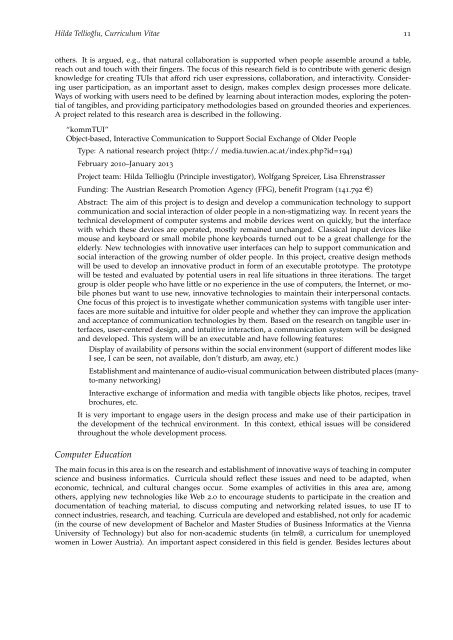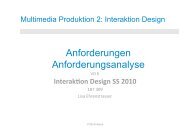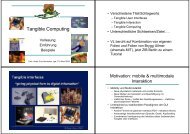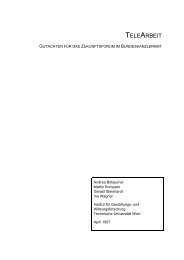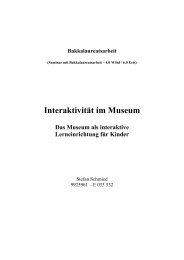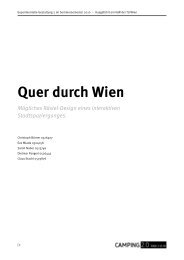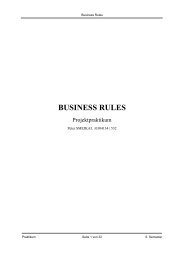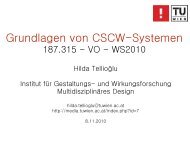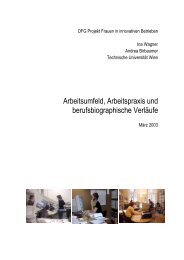Hilda Tellioglu, Curriculum Vitae - Technische Universität Wien
Hilda Tellioglu, Curriculum Vitae - Technische Universität Wien
Hilda Tellioglu, Curriculum Vitae - Technische Universität Wien
You also want an ePaper? Increase the reach of your titles
YUMPU automatically turns print PDFs into web optimized ePapers that Google loves.
<strong>Hilda</strong> Tellio˘glu, <strong>Curriculum</strong> <strong>Vitae</strong> 11<br />
others. It is argued, e.g., that natural collaboration is supported when people assemble around a table,<br />
reach out and touch with their fingers. The focus of this research field is to contribute with generic design<br />
knowledge for creating TUIs that afford rich user expressions, collaboration, and interactivity. Considering<br />
user participation, as an important asset to design, makes complex design processes more delicate.<br />
Ways of working with users need to be defined by learning about interaction modes, exploring the potential<br />
of tangibles, and providing participatory methodologies based on grounded theories and experiences.<br />
A project related to this research area is described in the following.<br />
“kommTUI”<br />
Object-based, Interactive Communication to Support Social Exchange of Older People<br />
Type: A national research project (http:// media.tuwien.ac.at/index.php?id=194)<br />
February 2010–January 2013<br />
Project team: <strong>Hilda</strong> Tellio˘glu (Principle investigator), Wolfgang Spreicer, Lisa Ehrenstrasser<br />
Funding: The Austrian Research Promotion Agency (FFG), benefit Program (141.792 e)<br />
Abstract: The aim of this project is to design and develop a communication technology to support<br />
communication and social interaction of older people in a non-stigmatizing way. In recent years the<br />
technical development of computer systems and mobile devices went on quickly, but the interface<br />
with which these devices are operated, mostly remained unchanged. Classical input devices like<br />
mouse and keyboard or small mobile phone keyboards turned out to be a great challenge for the<br />
elderly. New technologies with innovative user interfaces can help to support communication and<br />
social interaction of the growing number of older people. In this project, creative design methods<br />
will be used to develop an innovative product in form of an executable prototype. The prototype<br />
will be tested and evaluated by potential users in real life situations in three iterations. The target<br />
group is older people who have little or no experience in the use of computers, the Internet, or mobile<br />
phones but want to use new, innovative technologies to maintain their interpersonal contacts.<br />
One focus of this project is to investigate whether communication systems with tangible user interfaces<br />
are more suitable and intuitive for older people and whether they can improve the application<br />
and acceptance of communication technologies by them. Based on the research on tangible user interfaces,<br />
user-centered design, and intuitive interaction, a communication system will be designed<br />
and developed. This system will be an executable and have following features:<br />
Display of availability of persons within the social environment (support of different modes like<br />
I see, I can be seen, not available, don’t disturb, am away, etc.)<br />
Establishment and maintenance of audio-visual communication between distributed places (manyto-many<br />
networking)<br />
Interactive exchange of information and media with tangible objects like photos, recipes, travel<br />
brochures, etc.<br />
It is very important to engage users in the design process and make use of their participation in<br />
the development of the technical environment. In this context, ethical issues will be considered<br />
throughout the whole development process.<br />
Computer Education<br />
The main focus in this area is on the research and establishment of innovative ways of teaching in computer<br />
science and business informatics. Curricula should reflect these issues and need to be adapted, when<br />
economic, technical, and cultural changes occur. Some examples of activities in this area are, among<br />
others, applying new technologies like Web 2.0 to encourage students to participate in the creation and<br />
documentation of teaching material, to discuss computing and networking related issues, to use IT to<br />
connect industries, research, and teaching. Curricula are developed and established, not only for academic<br />
(in the course of new development of Bachelor and Master Studies of Business Informatics at the Vienna<br />
University of Technology) but also for non-academic students (in telm@, a curriculum for unemployed<br />
women in Lower Austria). An important aspect considered in this field is gender. Besides lectures about


